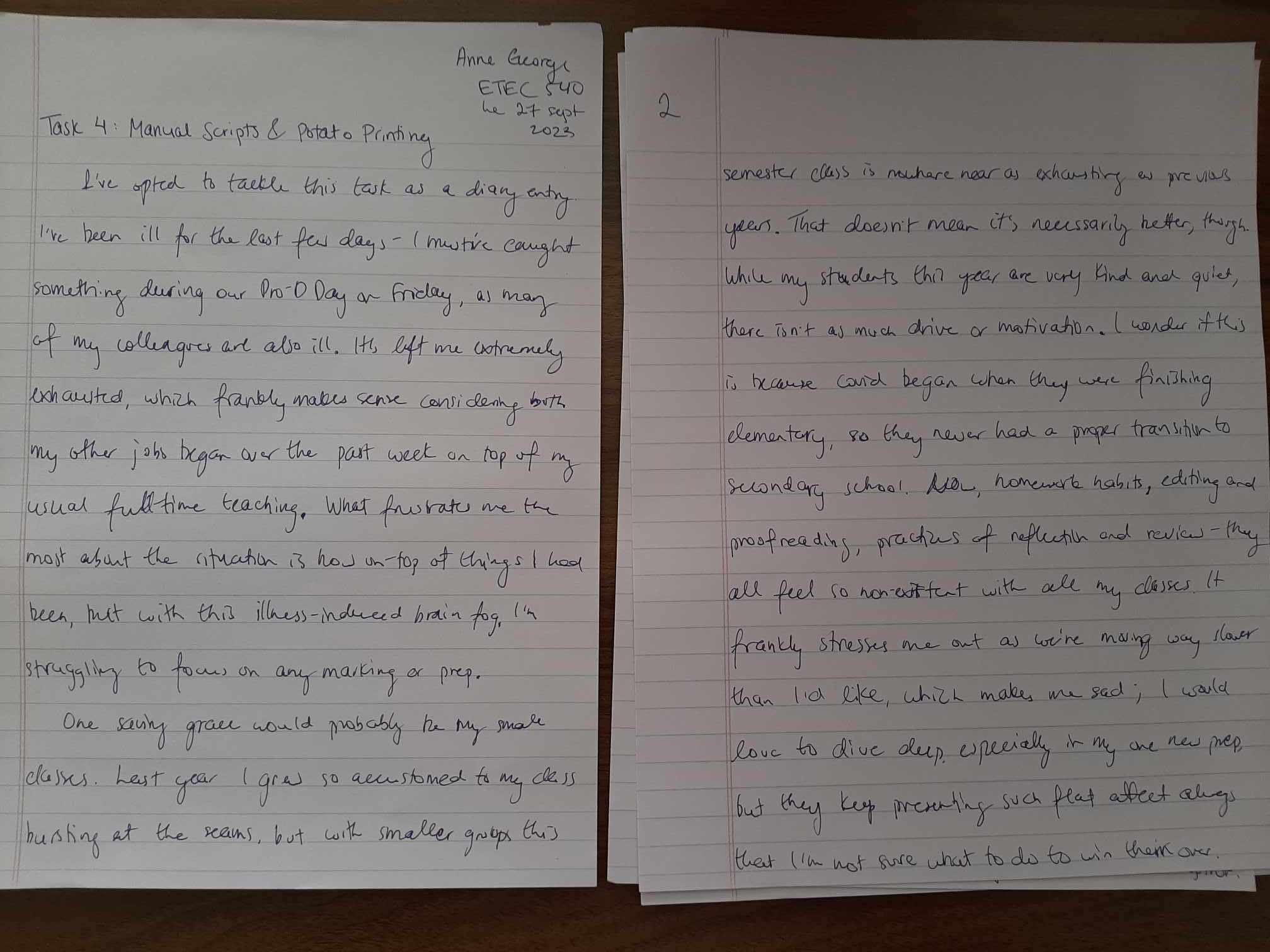Prompt: Introduce yourself to the instructor and your peers in ETEC 540 by taking a picture of an array of items from a bag you commonly carry. This task is meant to get you thinking about why you choose to transport such items with you.

What’s In My Bag?
My name is Anne, and I’m a secondary school teacher in Richmond, BC. The bag which I’ve chosen to analyse is the little backpack purse which I take with me everywhere besides when I go to work; it is rather light currently due to the fact that the school year has just begun, so I have moved many things to my work bag. Despite this, throughout the year, this small bag is reliably always the one I take with me whenever I need to go anywhere, regardless of the occasion. It sits on the small armchair in front of the door to my cosy little apartment, always ready for me to throw my keys in and head out on an adventure. I’ve had it for two years now, and it has been quite reliable.
Within this bag, I always pack the same items: whatever novel I am reading at the moment, a reusable shopping bag, my wallet, lip gloss, perfume, a granola bar, a foldable umbrella, a reusable mask, a sunscreen stick, and some tools for homework grading like my favourite style of pen and highlighter. There are no digital texts within my bag, although nearly everything within my bag has some sort of text which has been digitally produced and printed. However, I will note that I did not include my cellphone and my headphones, which I always keep on me; as they are usually within my pockets and not items which I think of packing in my bag, they were excluded, although they are indispensable to any trip I take.
Text Technologies
In examining these items, it is fairly clear that the only true traditional “text” is the novel. Currently, it is a science fiction supernatural horror series that I’ve been making my way through, although my progress has been fairly slow due to having all my mental “reading space” be taken up by consistent coursework for the past year. The book itself is printed, with illustrations by my favourite artist sprinkled across a whole page every few chapters. Each of these illustrations is a joy to explore and analyse in relation to the fantastic prose. On a surface level, however, it is hard to detect the nature of my choice of books as I always wrap them in a protective canvas case covered in mathematical formulas. I suppose that this, too, is a type of text, as these designs need to be printed out by digital technologies onto the canvas. The fact that I chose this cover amongst all of the others available across Amazon (from which I ordered the cover originally) does indicate a level of mathematical literacy. The cover always makes my students groan when they witness it as they do not understand my love for math despite being a humanities teacher.
The reusable floral-patterned shopping bag has no text within it other than a printed materials tag, indicating its 100% polyester composition and a set of wash instructions told through symbols. These instructions, as minute as they are, require an understanding of the universal symbols utilised in similar clothing tags. The word “polyester”, however, appears in English, French, Italian, and Spanish, indicating the global market to which this product must have been marketed.
My wallet is filled with cards covered in texts in multiple forms; beyond the surface of the cards themselves relaying information about banks, libraries, store reward programs, and identification, the chips in my bank cards are meant to link to digital banking systems, and the account numbers and barcodes on almost every card connect my identity to my accounts across various services. A few Canadian bills of various denominations are always tucked into the back just in case I need cash, shining in English and French embedded as part of the currency’s counterfeit prevention features.
The mask and the umbrella only have labels representing their makers and brands. The mask’s tiny label tucked into the left hem reads, “Norwex Baclock: Improving Quality of Life”, while the strap upon the umbrella says “Lewis N. Clark”. No other information on materials, make, or care are provided upon these products.
The lip gloss, sunscreen, and granola bar all mainly contain labels and ingredient lists, although only one product here should actually be consumed. The granola bar and lipgloss both contain English and French labels as these products are meant to be distributed in Canada. The sunscreen, however, only has English written upon the printed label. This style of sunscreen is originally from South Korea, although I’m not sure if this particular product is a knock-off or not; still, the lack of French makes sense when noting that this was an internationally-shipped product ordered online. Strangely, there is a QR code upon the sunscreen stick’s label as well. Before this assignment, I never actually tested what this digital text, which is so indicative of our modern age where all information can be easily compressed into QR codes to scan for ease of access, was meant to provide to the users. I previously believed I would be led to a product page on their website. Instead, the QR code on the label only opened up a text note upon my phone with the product number with no further comments. Why this QR code is included is a mystery.
I always mark student work using the same brand of pen: a purple Pilot V5 Hi-Tecpoint rollerball ink pen. It reads as such upon the pen itself, containing no other text but a numberless barcode which can be scanned for individual sale. The highlighter brands vary for me, however; I run out of them fairly quickly. I am not entirely sure what brand this is, as the pen itself has no printing upon it. Why I carry these two items with me when this bag is neither big enough to hold any A4 paper nor my laptop, I am not sure. It is more just a habit to always have these items with me than any actual need for them in the circumstances during which I use this bag.
The only item completely free of any kind of writing is my travel-sized perfume bottle. It is simply metallic purple with a tiny window to show how much product is remaining. Even when I bought this bottle, I remember the pack in which it arrived containing no instructions whatsoever, leaving it up to the consumer to figure out how to fill them up.
Reflection
The contents of this bag paint the image of someone who is generally on-the-go and always prepared. Hungry? Here’s a snack. Need a touch-up? Light makeup and toiletries are all you need. Bored? Here’s a novel. Need groceries on the way home? Here’s a shopping bag. Is it starting to rain in the always-drizzling Lower Mainland? Enjoy the umbrella. Had I done this activity in two months time, there would have also been a pair of warm gloves within the bag accompanying the umbrella.
I do believe this to be a fairly accurate depiction of who I am normally; if I had done this activity with my larger work bag, there would be even more items which support this, such as lozenges for coughs, painkillers, a notebook, and more, alongside all the things within this small backpack. This penchant for preparation has not changed for over a decade, stemming from much travelling and touring for orchestras and aviation when I was a teenager; thus, I am always ready to pick up my gear and head on the road with an enjoyable book to keep me company.
The globality of the contents of my bag would likely be a key point to any archeologist who stumbles upon this bag. The umbrella is American; the snack is Canadian; the pen and novel are originally from Japanese companies, although both products were printed and made in the USA; the sunscreen is based on a Korean make; and the mask is from a Norwegian brand. These indicate that I have access to the global marketplace, showcasing the interconnectedness of the economy and production of daily items. There are various languages on the products, which indicate multilingualism on my part, as there is no way to clarify that I only speak two out of the four languages found in the contents of my bag. Had this been my work bag, that would have been much easier to specify as I always have English and French texts with me.
It is strange to witness just how little text is present on items aside from my novel. The need for basic literacy is present in examining almost every single item, as text exists in written, visual, or symbolic form; every item within my bag has, at some point, interacted with text-based devices, requiring textual input in order to complete production. Despite that, the only item whose meaning relies upon its textual contents is the novel itself. I suppose this fact is so startling to me as literacy is (for good reason) such a vital part of education, and yet, it is so apart from our physical daily lives beyond small textual exchanges if not intentionally included in our daily routine in the form of reading material. In contrast, digital text upon phones and computers is far more prevalent in our modern age. The constant interaction between the physical and digital world requires the swift navigation of the borderlines of all forms of textual literacies in order to make meaning in combined textual contexts, rather than in the individual labels and symbols which mark any given item. In isolation, my bag is scattered, random. In combination, however, a story emerges from within- life is simple and peaceful, and despite being busy and on-the-go, I can take on whatever comes my way.










